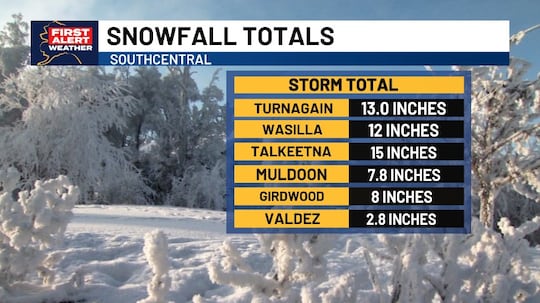Alaska
Avalanche kills 1 backcountry skier, leaves 2 others with head injuries in Alaska

The avalanche came roaring down near the Seward Highway on the Kenai Peninsula south of Anchorage on Tuesday, sweeping the skiers away as they were ascending a mountain
An avalanche in Alaska has killed one backcountry skier and left two others with head injuries.
The avalanche came roaring down near the Seward Highway on the Kenai Peninsula on Tuesday, sweeping the skiers away as they were ascending a mountain in the backcountry, Alaska State Troopers said Wednesday.
The skier who was killed was as 28-year-old Joseph Allen of Anchorage. The two men he was with are expected to survive.
Authorities are reminding the public that “anyone who engages in backcountry recreational activities to please check the local avalanche conditions before setting out,” according to a Facebook post made by Cooper Landing Emergency Services.
“Always be prepared with the appropriate safety gear regardless of how safe and experienced you might be!” the post says. “These victims had all the necessary safety gear and it still proved deadly.”
More about what happened
The group of men were climbing a peak along the highway in order to ski down when their movement triggered an avalanche that swept them away just south of Anchorage, troopers said.
The two men found alive were able to climb out after being buried, but Allen could not be found.
First responders were eventually able to extricate all three men off the remote mountain “at a significant elevation,” Cooper Landing said in its post.
Allen was pronounced dead at the scene, and the other two men were flown to taken to a hospital with what’s expected to be non-life-threatening injuries, Cooper Landing said.

Alaska
Dozens of vehicle accidents reported, Anchorage after-school activities canceled, as snowfall buries Southcentral Alaska

ANCHORAGE, Alaska (KTUU) – Up to a foot of snow has fallen in areas across Southcentral as of Tuesday, with more expected into Wednesday morning.
All sports and after-school activities — except high school basketball and hockey activities — were canceled Tuesday for the Anchorage School District. The decision was made to allow crews to clear school parking lots and manage traffic for snow removal, district officials said.
“These efforts are critical to ensuring schools can safely remain open [Wednesday],” ASD said in a statement.
The Anchorage Police Department’s accident count for the past two days shows there have been 55 car accidents since Monday, as of 9:45 a.m. Tuesday. In addition, there have been 86 vehicles in distress reported by the department.
The snowfall — which has brought up to 13 inches along areas of Turnagain Arm and 12 inches in Wasilla — is expected to continue Tuesday, according to latest forecast models. Numerous winter weather alerts are in effect, and inland areas of Southcentral could see winds up to 25 mph, with coastal areas potentially seeing winds over 45 mph.
Some areas of Southcentral could see more than 20 inches of snowfall by Wednesday, with the Anchorage and Eagle River Hillsides, as well as the foothills of the Talkeetna Mountain, among the areas seeing the most snowfall.
See a spelling or grammar error? Report it to web@ktuu.com
Copyright 2026 KTUU. All rights reserved.
Alaska
Yundt Served: Formal Charges Submitted to Alaska Republican Party, Asks for Party Sanction and Censure of Senator Rob Yundt

On January 3, 2026, Districts 27 and 28 of the Alaska Republican Party received formal charges against Senator Rob Yundt pursuant to Article VII of the Alaska Republican Party Rules.
According to the Alaska Republican Party Rules: “Any candidate or elected official may be sanctioned or censured for any of the following
reasons:
(a) Failure to follow the Party Platform.
(b) Engagement in any activities prohibited by or contrary to these rules or RNC Rules.
(c) Failure to carry out or perform the duties of their office.
(d) Engaging in prohibited discrimination.
(e) Forming a majority caucus in which non-Republicans are at least 1/3 or more of the
coalition.
(f) Engaging in other activities that may be reasonably assessed as bringing dishonor to
the ARP, such as commission of a serious crime.”
Party Rules require the signatures of at least 3 registered Republican constituents for official charges to be filed. The formal charges were signed by registered Republican voters and District N constitutions Jerad McClure, Thomas W. Oels, Janice M. Norman, and Manda Gershon.
Yundt is charged with “failure to adhere and uphold the Alaska Republican Party Platform” and “engaging in conduct contrary to the principles and priorities of the Alaska Republican Party Rules.” The constituents request: “Senator Rob Yundt be provided proper notice of the charges and a full and fair opportunity to respond; and that, upon a finding by the required two-thirds (2/3) vote of the District Committees that the charges are valid, the Committees impose the maximum sanctions authorized under Article VII.”
If the Party finds Yundt guilty of the charges, Yundt may be disciplined with formal censure by the Alaska Republican Party, declaration of ineligibility for Party endorsement, withdrawal of political support, prohibition from participating in certain Party activities, and official and public declaration that Yundt’s conduct and voting record contradict the Party’s values and priorities.
Reasons for the charges are based on Yundt’s active support of House Bill 57, Senate Bill 113, and Senate Bill 92. Constituents who filed the charges argue that HB 57 opposes the Alaska Republican Party Platform by “expanding government surveillance and dramatically increasing education spending;” that SB 113 opposes the Party’s Platform by “impos[ing] new tax burdens on Alaskan consumers and small businesses;” and that SB 92 opposes the Party by “proposing a targeted 9.2% tax on major private-sector energy producer supplying natural gas to Southcentral Alaska.” Although the filed charges state that SB 92 proposes a 9.2% tax, the bill actually proposes a 9.4% tax on income from oil and gas production and transportation.
Many Alaskan conservatives have expressed frustration with Senator Yundt’s legislative decisions. Some, like Marcy Sowers, consider Yundt more like “a tax-loving social justice warrior” than a conservative.
Related
Alaska
Pilot of Alaska flight that lost door plug over Portland sues Boeing, claims company blamed him

The Alaska Airlines captain who piloted the Boeing 737 Max that lost a door plug over Portland two years ago is suing the plane’s manufacturer, alleging that the company has tried to shift blame to him to shield its own negligence.
The $10 million suit — filed in Multnomah County Circuit Court on Tuesday on behalf of captain Brandon Fisher — stems from the dramatic Jan. 5, 2024 mid-air depressurization of Flight 1282, when a door plug in the 26th row flew off six minutes after take off, creating a 2-by-4-foot hole in the plane that forced Fisher and co-pilot Emily Wiprud to perform an emergency landing back at PDX.
None of the 171 passengers or six crew members on board was seriously injured, but some aviation medical experts said that the consequences could have been “catastrophic” had the incident happened at a higher altitude.
Fisher’s lawsuit is the latest in a series filed against Boeing, including dozens from Flight 1282 passengers. It also names Spirit AeroSystems, a subcontractor that worked on the plane.
The lawsuit blames the incident on quality control issues with the door plug. It argues that Boeing caught five misinstalled rivets in the panel, and that Spirit employees painted over the rivets instead of reinstalling them correctly. Boeing inspectors caught the discrepancy again, the complaint alleges, but when employees finally reopened the panel to fix the rivets, they didn’t reattach four bolts that secured the door panel.
The complaint’s allegations that Boeing employees failed to secure the bolts is in line with a National Transportation Safety Board investigation that came to the conclusion that the bolts hadn’t been replaced.
Despite these internal issues, Fisher claims Boeing deliberately shifted blame towards him and his first officer.
Lawyers for Boeing in an earlier lawsuit wrote that the company wasn’t responsible for the incident because the plane had been “improperly maintained or misused by persons and/or entities other than Boeing.”
Fisher’s complaint alleges that the company’s statement was intended to “paint him as the scapegoat for Boeing’s numerous failures.”
“Instead of praising Captain Fisher’s bravery, Boeing inexplicably impugned the reputations of the pilots,” the lawsuit says.
As a result, Fisher has been scrutinized for his role in the incident, the lawsuit alleges, and named in two lawsuits by passengers.
Spokespeople for Boeing and Spirit AeroSystems declined to comment on the lawsuit.
-

 World1 week ago
World1 week agoHamas builds new terror regime in Gaza, recruiting teens amid problematic election
-

 News1 week ago
News1 week agoFor those who help the poor, 2025 goes down as a year of chaos
-

 Business1 week ago
Business1 week agoInstacart ends AI pricing test that charged shoppers different prices for the same items
-

 Health1 week ago
Health1 week agoDid holiday stress wreak havoc on your gut? Doctors say 6 simple tips can help
-

 Technology1 week ago
Technology1 week agoChatGPT’s GPT-5.2 is here, and it feels rushed
-

 Business1 week ago
Business1 week agoA tale of two Ralphs — Lauren and the supermarket — shows the reality of a K-shaped economy
-

 Science1 week ago
Science1 week agoWe Asked for Environmental Fixes in Your State. You Sent In Thousands.
-

 Politics1 week ago
Politics1 week agoThe biggest losers of 2025: Who fell flat as the year closed























